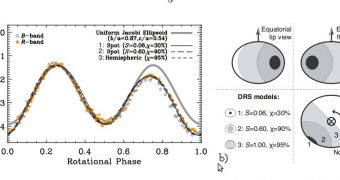The Kuiper Belt is a ring of space rocks surrounding the outskirts of the solar system, around the orbit of Pluto and beyond. The formation is similar to the inner asteroid belt, and is one of the major sources for the comets that pass through our solar system. The Belt contains a large number of significant objects, including bodies that were classified as dwarf planets in the past. Haumea, Eris, Sedna and Makemake are among the largest such bodies, and they have constituted a subject of study for a long time. Now, recent investigations of Haumea reveal the first-ever identified structure on the surface of any of these celestial bodies, Technology Review reports.
Haumea's history is rather recent. It was discovered in 2004 by Sierra Nevada Observatory astronomer J. L. Ortiz, who observed that the body revolved around the Sun at a distance ranging from 34 to 51 AU (astronomical units). Such a unit is equivalent to the average distance between the Earth and the Sun. The dwarf planet is one of the weirdest such bodies in the solar system, because of its shape, but also because of its peculiar orbit. It weighs in at about 33 percent of Pluto's mass, and keeps two moons in its orbit at all times. Its orbit forced it to take a peculiar, elongated shape, which intrigues astronomers.
In its distant past, Haumea was most likely stricken by another planet, or by a large comet. Experts inferred that from its fast rotational speed. The body spins around itself once every 3.9 hours, which makes it the fastest such structure known thus far. Only a strong collision in its distant past would explain this massive speed. But one of the most important things about it is that it appears to be covered in water-ice. The same holds true for its moons. Astrophysicists believe this is why the three bodies have a blue tinge to them.
The vast majority of other Kuiper Belt objects are covered in methane, and have a slightly reddish tint to them. But astronomers suspect that Haumea may be harboring a rocky core, as its density is a lot higher than that of water. Using the University of Hawaii's 2.2-meter telescope, astronomer Pedro Lacerda, from the Queen's University in Belfast, has discovered another peculiarity, namely a dark-red spot on the surface of the moon. This represents the first time ever a Kuiper Belt object, other than Pluto, is imaged in such detail.
There are only two possibilities of what may generate the spot, the expert says. It may either be the planet's interior coming to the surface, or it may be caused by an impact with a smaller Kuiper Belt object, most of which are known for being covered in red, organic matter. Lacerda excludes the possibility of the signature being generated by mountains or other such features, because that would change the blue tint of the dwarf planet in an easily distinguishable manner.

 14 DAY TRIAL //
14 DAY TRIAL //